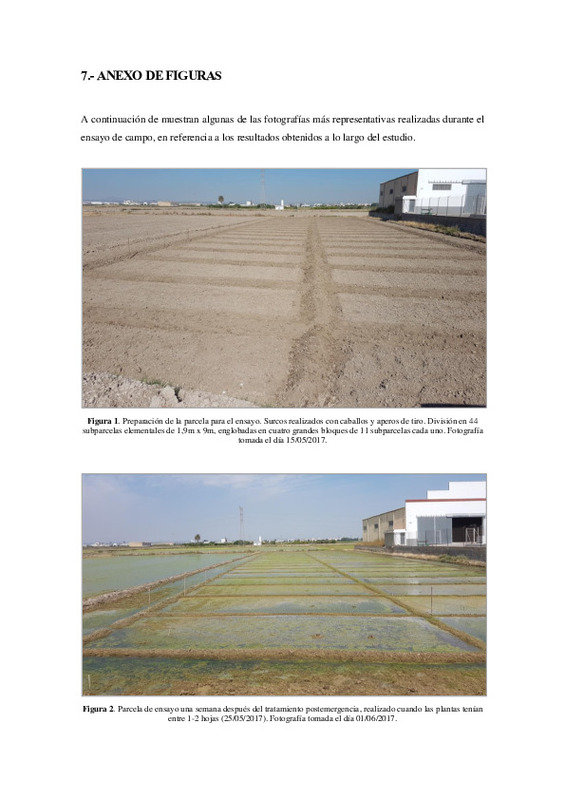JavaScript is disabled for your browser. Some features of this site may not work without it.
Buscar en RiuNet
Listar
Mi cuenta
Estadísticas
Ayuda RiuNet
Admin. UPV
Control de Leptochloa en arrozales de la Albufera valenciana
Mostrar el registro sencillo del ítem
Ficheros en el ítem
| dc.contributor.advisor | Osca Lluch, José María
|
es_ES |
| dc.contributor.advisor | Luca Fabra, Verónica de
|
es_ES |
| dc.contributor.author | García Rodríguez, Juan Manuel
|
es_ES |
| dc.date.accessioned | 2017-09-20T09:03:08Z | |
| dc.date.available | 2017-09-20T09:03:08Z | |
| dc.date.created | 2017-07-20 | |
| dc.date.issued | 2017-09-20 | es_ES |
| dc.identifier.uri | http://hdl.handle.net/10251/87602 | |
| dc.description.abstract | [ES] Desde hace años, la problemática de las malas hierbas en el cultivo del arroz en la Albufera valenciana y alrededores se ha visto acrecentada debido, entre otros factores, a la falta de eficacia de los tratamientos herbicidas que se realizan, bien por aplicaciones inadecuadas o por aumento de tolerancia con el paso de las generaciones. Si a esto se le suma la enorme facilidad de dispersión de las semillas y la aparición de nuevas malas hierbas que promueven la competencia con el cultivo, se llega a una situación de inestabilidad que acaba suponiendo una de las mayores preocupaciones de los agricultores de la zona y de los productores del sector. El género Leptochloa es una de las principales malas hierbas de reciente introducción que afecta a este cultivo y será el objeto del presente estudio, en el que se han ensayado distintas materias activas bajo condiciones controladas (invernadero) y en condiciones reales (ensayos de campo), con el fin de conocer los métodos o alternativas químicas más eficaces para su control. En el ensayo de invernadero se han comparado nuevos herbicidas y herbicidas tradicionales, tanto de preemergencia como de postemergencia. Los resultados en el primer caso han sido positivos. Por el contrario, los resultados obtenidos en postemergencia han tenido menor eficacia, debido a la mayor tolerancia que mostraban las dos subespecies trabajadas: Leptochloa fusca (L.) Kunth subsp. uninervia (J. Presl) y Leptochloa fusca (L.) Kunth subsp. fascicularis (Lam.). En el ensayo de campo, utilizando la variedad de arroz “J. Sendra”, los resultados observados han sido más heterogéneos, especialmente en postemergencia. En este ensayo, también se han utilizado las dos subespecies del género Leptochloa. | es_ES |
| dc.description.abstract | [EN] For years, weeds in rice cultivation in the Albufera of Valencia have been increasing due to, among other factors, the lack of effectiveness of the herbicide treatments that are carried out, either by inadequate applications or by increased tolerance with the passing of generations. Add to this the enormous ease of dispersion of the seeds and the appearance of new weeds that promote competition with the crop, a situation of instability that ends up assuming one of the biggest concerns of the farmers of the zone and the producers of the sector. The genus Leptochloa is one of the main newly introduced weeds that affects this crop and will be the object of the present study, in which different active substances have been tested under controlled conditions (greenhouse) and under real conditions (field trials), with the in order to know the most effective chemical methods or alternatives for its control. In the greenhouse test, new herbicides and traditional herbicides, both preemergence and postemergence, have been compared. The results in the first case have been positive. On the contrary, the results obtained in postemergence have been less efficient, due to the greater tolerance of the two subspecies studied: Leptochloa fusca (L.) Kunth subsp. uninervia (J. Presl) and Leptochloa fusca (L.) Kunth subsp. fascicularis (Lam.). In the field trial, using the “J. Sendra” rice variety and the two subspecies of the genus Leptochloa, the observed results have been more heterogeneous, especially in postemergence. | es_ES |
| dc.format.extent | 51 | es_ES |
| dc.language | Español | es_ES |
| dc.publisher | Universitat Politècnica de València | es_ES |
| dc.rights | Reserva de todos los derechos | es_ES |
| dc.subject | Herbicides | es_ES |
| dc.subject | weeds | es_ES |
| dc.subject | rice | es_ES |
| dc.subject | chemical control | es_ES |
| dc.subject | Leptochloa | es_ES |
| dc.subject | malas hierbas | es_ES |
| dc.subject | arroz | es_ES |
| dc.subject | control químico | es_ES |
| dc.subject | Herbicidas | es_ES |
| dc.subject.classification | PRODUCCION VEGETAL | es_ES |
| dc.subject.other | Máster Universitario en Ingeniería Agronómica-Master Universitari en Enginyeria Agronòmica | es_ES |
| dc.title | Control de Leptochloa en arrozales de la Albufera valenciana | es_ES |
| dc.type | Tesis de máster | es_ES |
| dc.rights.accessRights | Abierto | es_ES |
| dc.contributor.affiliation | Universitat Politècnica de València. Escuela Técnica Superior de Ingeniería Agronómica y del Medio Natural - Escola Tècnica Superior d'Enginyeria Agronòmica i del Medi Natural | es_ES |
| dc.contributor.affiliation | Universitat Politècnica de València. Departamento de Producción Vegetal - Departament de Producció Vegetal | es_ES |
| dc.description.bibliographicCitation | García Rodríguez, JM. (2017). Control de Leptochloa en arrozales de la Albufera valenciana. http://hdl.handle.net/10251/87602 | es_ES |
| dc.description.accrualMethod | TFGM | es_ES |
| dc.relation.pasarela | TFGM\71978 | es_ES |
Este ítem aparece en la(s) siguiente(s) colección(ones)
-
ETSIAMN - Trabajos académicos [3541]
Escuela Técnica Superior de Ingeniería Agronómica y del Medio Natural







